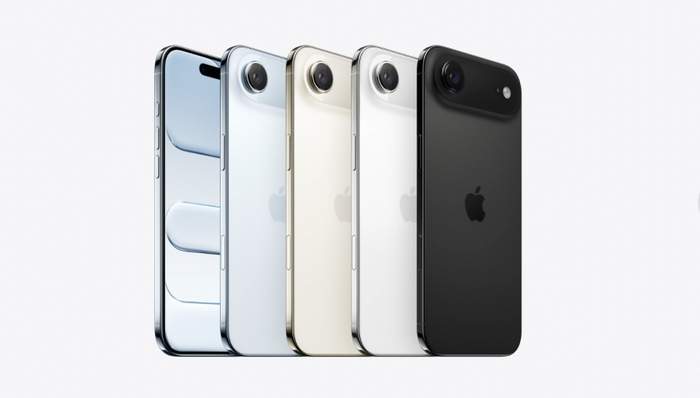
When Apple announced on its official website that the iPhone Air would officially enter the Chinese market on October 22, the public had hoped that this "thinnest iPhone in history" would continue the innovation myth of the Steve Jobs era. But reality quickly poured cold water: inventory continued to pile up during the pre-sale period, becoming the only flagship model of Apple that has not been sold out in recent years; The third-party platform lowered its price by 300 to 1000 yuan upon its initial launch, and nearly 70% of users on Xianyu were bearish on its residual value; Even more shocking is that the order volume in November was less than 10% of that in September, forcing Apple to cut orders by one million units and suspend production lines. This new device, which carries Apple's lightweight strategy, quickly cooled down due to the inevitable result of a triple mismatch between product positioning, user demand, and market environment.
The compromise of product design functionality has become the first hurdle to discourage users. Apple has made a fatal concession in the core experience to achieve an ultimate thickness of 5.6mm and a weight of 165g. The most criticized aspect is the short battery life - the 3149mAh battery capacity is significantly different from the 5000mAh battery commonly used in mainstream flagship phones, and can only support 5-6 hours of heavy use. Users are forced to purchase an additional MagSafe external battery for 799 yuan, which has become a "burden of giving away when buying a phone". This practice of sacrificing practicality for slimness is seriously disconnected from the usage scenario of contemporary users who never leave their phones.
The reduction in configuration is even more difficult for consumers to accept. The combination of a single camera and a single speaker was roast by netizens that "even a thousand yuan Android machine is inferior", and the old USB 2.0 interface completely lags behind the mainstream USB 3.2 and even the lightning interface standard in the industry. Even more fatal is the issue of heat dissipation. The A19 Pro chip is forcibly inserted into the ultra-thin body, causing the frequency to decrease due to overheating after playing games for 15 minutes. The body temperature skyrockets to 45 ℃, and in summer, there is even an embarrassing scene of "feeling hot in your pocket". The claim on Apple's official website of "excellent battery life that meets all day needs" and "professional level performance" has become empty talk in actual use, and this gap between promotion and experience seriously undermines user trust.
The unsuitability of eSIM technology has become a key bottleneck restricting market penetration. Apple adopts a pure eSIM design to save internal space, but ignores the special ecology of the Chinese market. Domestic users need to go to the offline business hall to verify their identity when activating eSIM, and there is a limit of 5 card replacements per month. The overseas version can bind 8 eSIM cards, while the domestic version only supports 2 cards, and even the Hong Kong version is not compatible with mainland operators. This "global unified strategy" is like a chicken rib for domestic users: roaming abroad requires deleting the domestic card number, the operation is cumbersome when changing operators, and elderly users feel uncomfortable with the design without physical cards.
The adaptation defects of communication technology directly affect the core user experience. Although Apple emphasizes the "flexible security" of eSIM and has received support from the three major telecom operators, many restrictions in actual operation greatly reduce its convenience. Compared to the common practice of Android models retaining physical SIM card slots, the eSIM design of iPhone Air seems neither suitable for local needs nor lacks alternative solutions, forcibly blocking a large number of users who require communication stability. In the current era where mobile phones still need to undertake basic communication functions, this technology choice that is detached from the actual market is undoubtedly a self imposed threshold.
The current smartphone market has entered the stage of "pragmatic return", with foldable screens and AI smartphones becoming new innovative directions. Users value comprehensive experience more than the extreme of a single parameter. Apple, however, is obsessed with the single innovation of "thin and light", attempting to open up new markets with flashy design, ignoring consumers' insistence on core needs such as battery life, imaging, and performance. This strategic choice of deviating from the mainstream market trend has destined the fate of the iPhone Air market. Apple's attempt to use 3D printed titanium alloy, eSIM and other technologies for this model is more like a technical experiment for foldable iPhone, rather than truly creating value for users.
The cold reception of iPhone Air is not accidental, but a concentrated manifestation of Apple's lack of innovation and sluggish market perception. From iPhone X to iPhone 17, Apple's innovation has mostly focused on parameter iteration and material upgrades, and has long lost the ability for disruptive innovation. The sacrifice of core experience for the pursuit of slimness, the neglect of local demand for the implementation of unified standards, and the establishment of imbalanced pricing to maintain profits are essentially the replacement of user centricism by enterprise centricism.
The smartphone industry has long passed the era of "innovation for innovation", and users need products that solve practical pain points, rather than flashy works that sacrifice experience. The failure of iPhone Air sounded an alarm for Apple: no matter how strong the brand halo is, it cannot withstand the continuous overdraft of product strength.

U.S. Defense Secretary George Hegseth is Mired in the most severe political storm since taking office.
U.S. Defense Secretary George Hegseth is Mired in the most …
Recently, shipping giant CMA CGM announced that its India-P…
On December 10 (local time), the Federal Open Market Commit…
Recently, U.S. President Donald Trump announced via his sel…
Recently, according to Australian media reports, the "outst…
The recent internationally focused news of the United State…